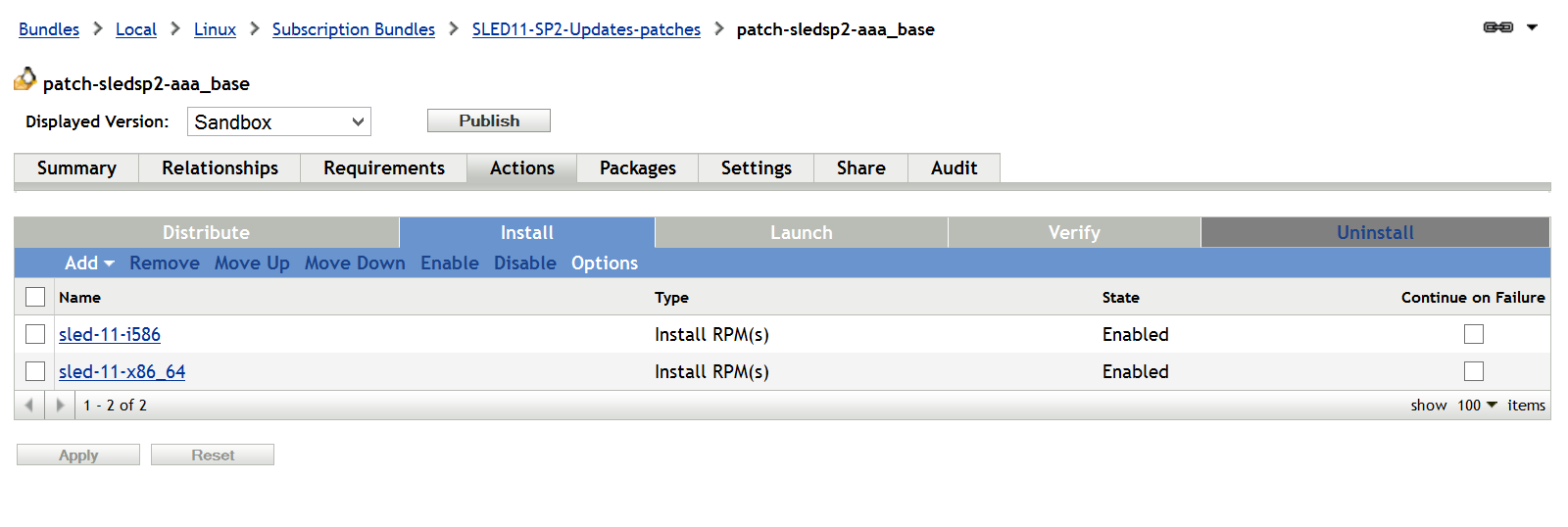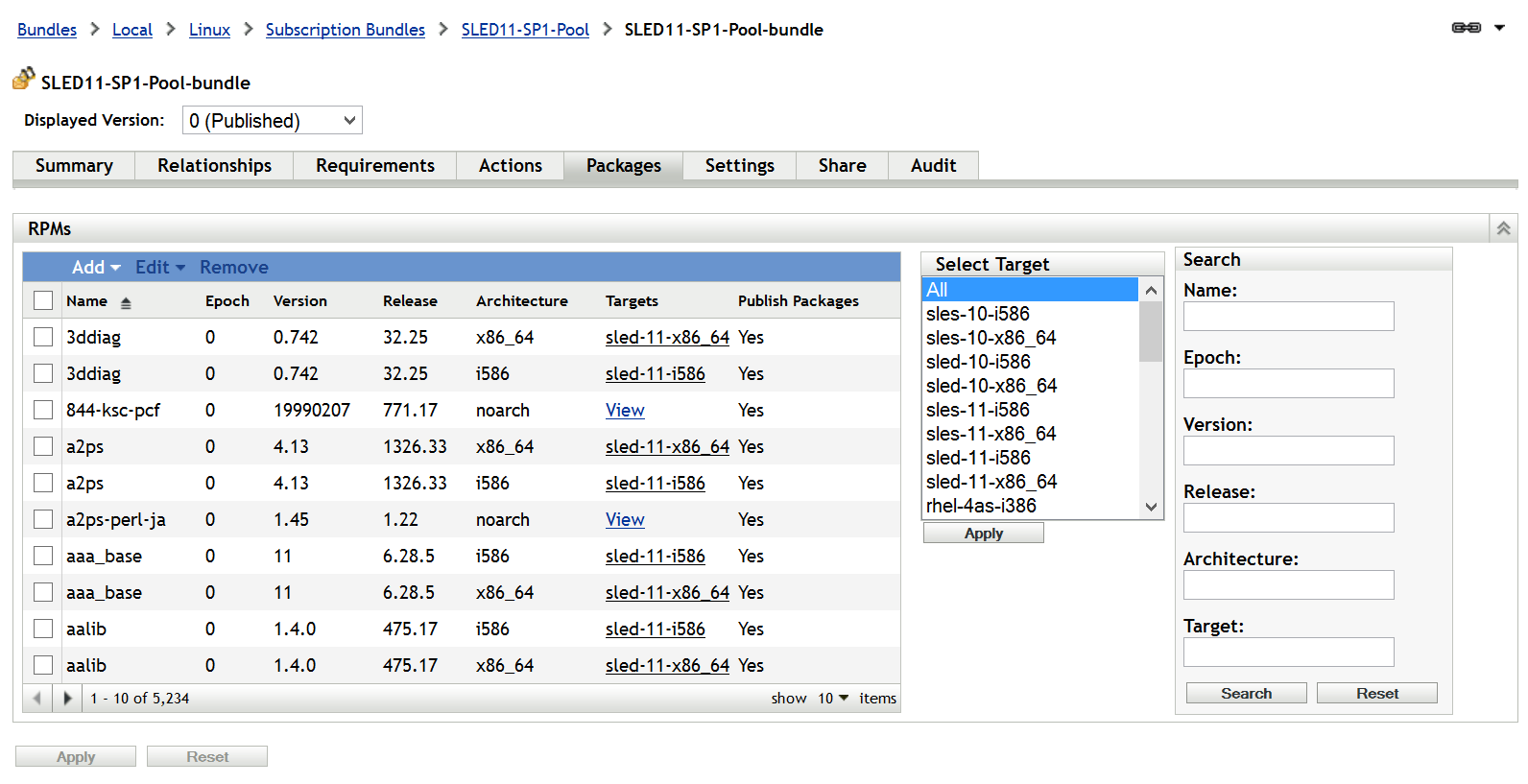3.10 Linux Package Management
ZENworks provides a robust system to facilitate the distribution of RPM packages to your Linux Servers and Desktops. This package management system includes capabilities such as recursive dependency resolution, mixed distribution of packages and other actions, and even the ability to service unmanaged devices for the purpose of deploying packages. Before discussing the best practices, it is important to understand the three main ways that the ZENworks agent can be made aware of packages. The rest of this section includes the following:
3.10.1 Linux Bundles
Linux bundles are the typical bundles that you will use when you want to deploy and configure a piece of software, configuration files, and other actions in an ordered fashion. With a Linux bundle you have the standard action sets common to all bundles: Distribute, Install, Launch and Uninstall as shown in the screen show below:

As with Windows bundles, you can create ordered sets of actions that will be processed when the bundle is executed. Linux bundles can be assigned to devices, device groups and folders. When a Linux bundle is assigned to a device, the metadata of any RPM in any Install RPM action is cached to the workstation on refresh so that if other bundle installs or package installs require packages that are a part of this bundle, they can be automatically installed during dependency resolution. However, as with Windows bundles the actions in the Install or Launch action sets are not transacted until the user either uses the zac bundle-install command or the ZENworks Window to execute the bundle. When the bundle is executed all the content associated with the bundle is cached and all the actions in the bundle are executed.
Linux bundles are ideal when you want to perform software installs as an atomic unit of work, such as installing a web server. A Linux bundle for this task might first install the relevant Apache2 web server packages, modify the web server configuration files, deploy a set of web content to the data folder and then flag the service to start in runlevels 3 and 5. Linux bundles are also typically used to drive the update of SUSE Linux Service Packs.
3.10.2 Linux Dependency Bundles
A Linux Dependency Bundle is similar in function to the ZENworks Linux Management catalog object. When you create a Linux Dependency Bundle you do not add actions, you typically add packages directly and the system adds Distribute RPM actions which ensure that the metadata is distributed to the devices. There is no ordered set of actions in a Linux Dependency bundle, rather there is an action for each OS target platform that the bundle has packages assigned to. The purpose of a Linux Dependency Bundle is to provide a set of packages that can either be used for dependency resolution, or which can be used to manually install or update packages using the zac install, zac up or zac dup commands. The properties of a Linux Dependency Bundle are shown below:

When creating a Linux Dependency Bundle, you can choose to have the packages published or not. If you choose to publish the packages, these will show up in package searches and can be manually installed or upgraded using the appropriate commands. If you choose not to publish them, then the packages are only used for dependency resolution. It is typical to have the core operating system bundles as Linux Dependency Bundles that contain all of the bundles from a particular distribution. You can then assign that bundle to devices running that distribution and they will have access to all the base packages, for dependency resolution.
When the agent on the managed device refreshes, the RPM content metadata from all the packages that are part of the Linux Dependency Bundle are cached to the device, but the actual content files (rpms) are not. The RPMs stay on the server until the user requires that RPM.
3.10.3 External Services Policies
The ZENworks agent is capable of using packages from ZENworks bundles (Linux and LDB), RPM-MD Repositories (YUM), and YaST/ZYPP type libraries (SUSE) for dependency resolution. If you already have the base distro packages on a Kickstart or and AutoYaST server you may want to use an External Services policy to deploy the repository to the device instead of using a Linux Dependency Bundle. The main advantage is that you can have a single source for the operating system bundles. The properties of an External Service policy is shown below:

From this policy you can assign one or more repositories to be automatically registered with both ZENworks and the native packaging tools on the machine. This policy can then be assigned to devices, device groups or folders so that the repositories specified are automatically added to the machine on the next refresh.
3.10.4 Publishing ZENworks Bundles as YUM Repositories
Whenever RPM packages from external package repositories like NU or RHN are replicated to ZENworks Server, they are stored in the ZENworks content repositories as content. Sometimes it might be necessary for other package management tools like YaST/zypper or YUM to use this RPM content from the ZENworks Server in the local network instead of going to the remote NU or RHN server. You can do this by publishing the ZENworks bundle as a YUM repository. When you create a YUM service from a Linux bundle or Linux Dependency bundle, the packages of the bundle are published as a YUM repository on the ZENworks Server. The repository can then be added as an installation source for package management tools like YaST/zypper or YUM.
For example, suppose that you have installed SUSE Linux Enterprise Server or Open Enterprise Server 2 from media, but you have been applying updates by using ZENworks replicated bundles. If you try to install or edit any pattern or install a new package in YaST, you might get dependency resolution errors, because YaST has no knowledge of the package updates available on the ZENworks Server. It only has knowledge of the installed packages and packages available on the media. YaST must have access to the package updates in ZENworks Server to resolve the dependencies properly. However, YaST does not understand the ZENworks bundles and content format. The only way to provide access to ZENworks Server packages is to publish the ZENworks bundles containing the package updates as YUM repositories and add the YUM repositories as installation sources in YaST.
3.10.5 Linux Package Management Best Practices
The following are a the key best practices for Linux Package Management:
-
Use ZENworks subscriptions to subscribe to public repositories that may contain packages you need. For instance, if you want to have all the patches available for your platform, you should setup a SUSE or RedHat subscription.
-
Save space by re-using existing local repositories. If you already have a repository server that contains your distribution packages, use External Services policies to add these repositories to your managed devices. This allows the ZENworks Agent to leverage these servers for dependency resolution.
-
Use the option to create YUM repositories from a bundle or bundle group to allow a ZENworks server to act as a repository for unmanaged devices.
-
Use Linux Dependency Bundles if you want the user or dependency resolution to install packages.
-
Use Linux Bundles if you want ZENworks to install packages.
-
Use Linux Bundles if you need to do additional work above, beyond the package transaction.
-
Make sure that your Linux servers’ have a nearby content server as the Content servers are used to download all the RPM metadata and the actual RPMs themselves.